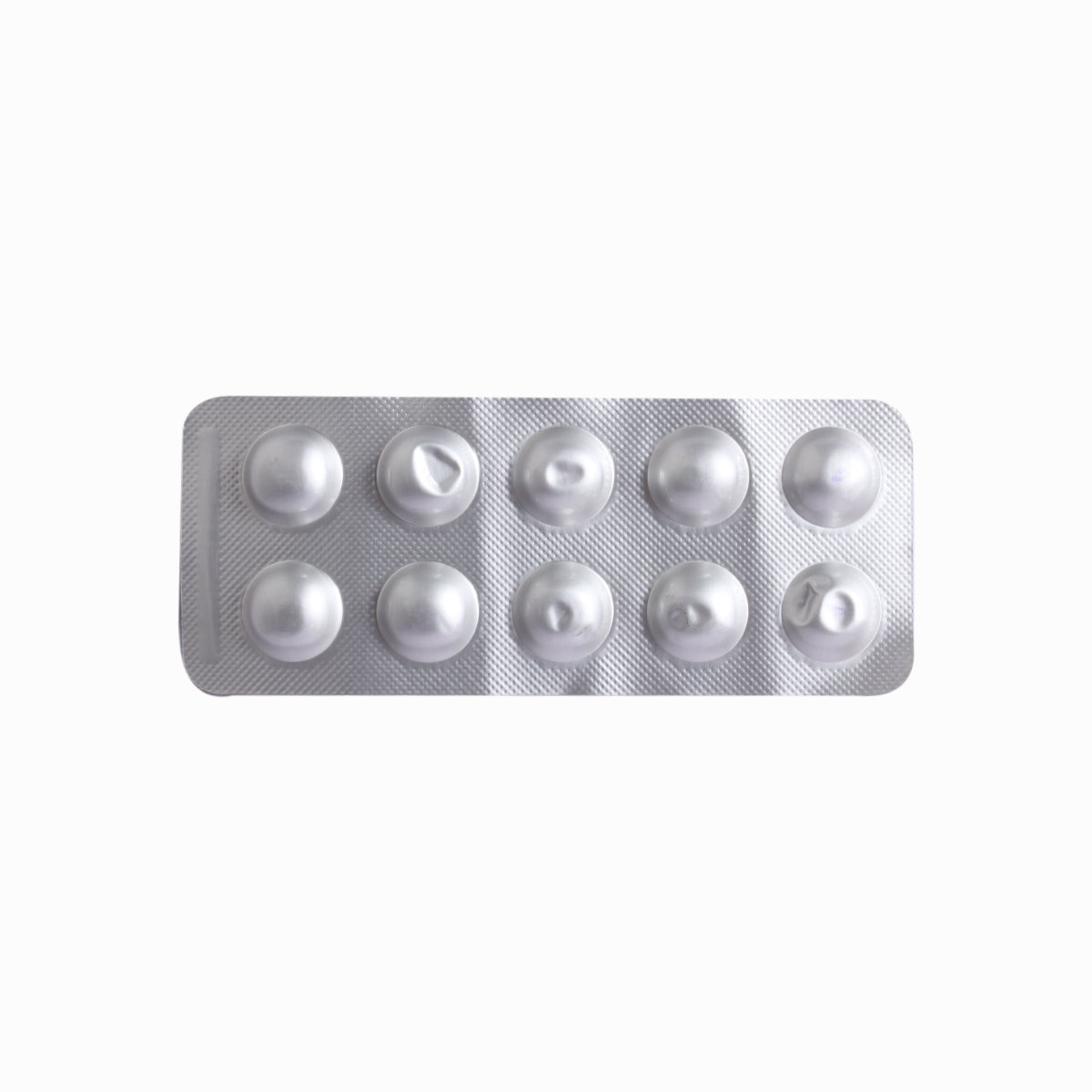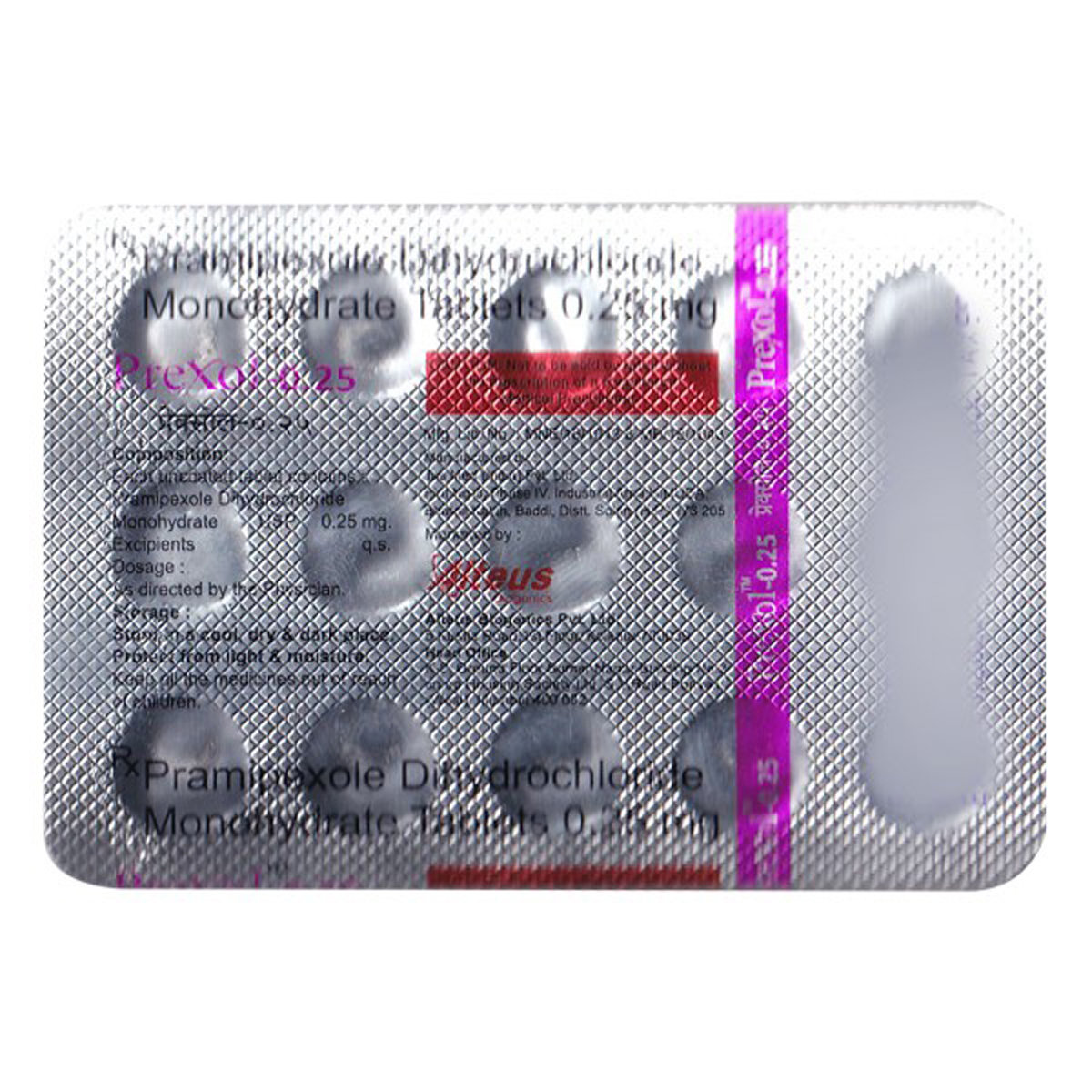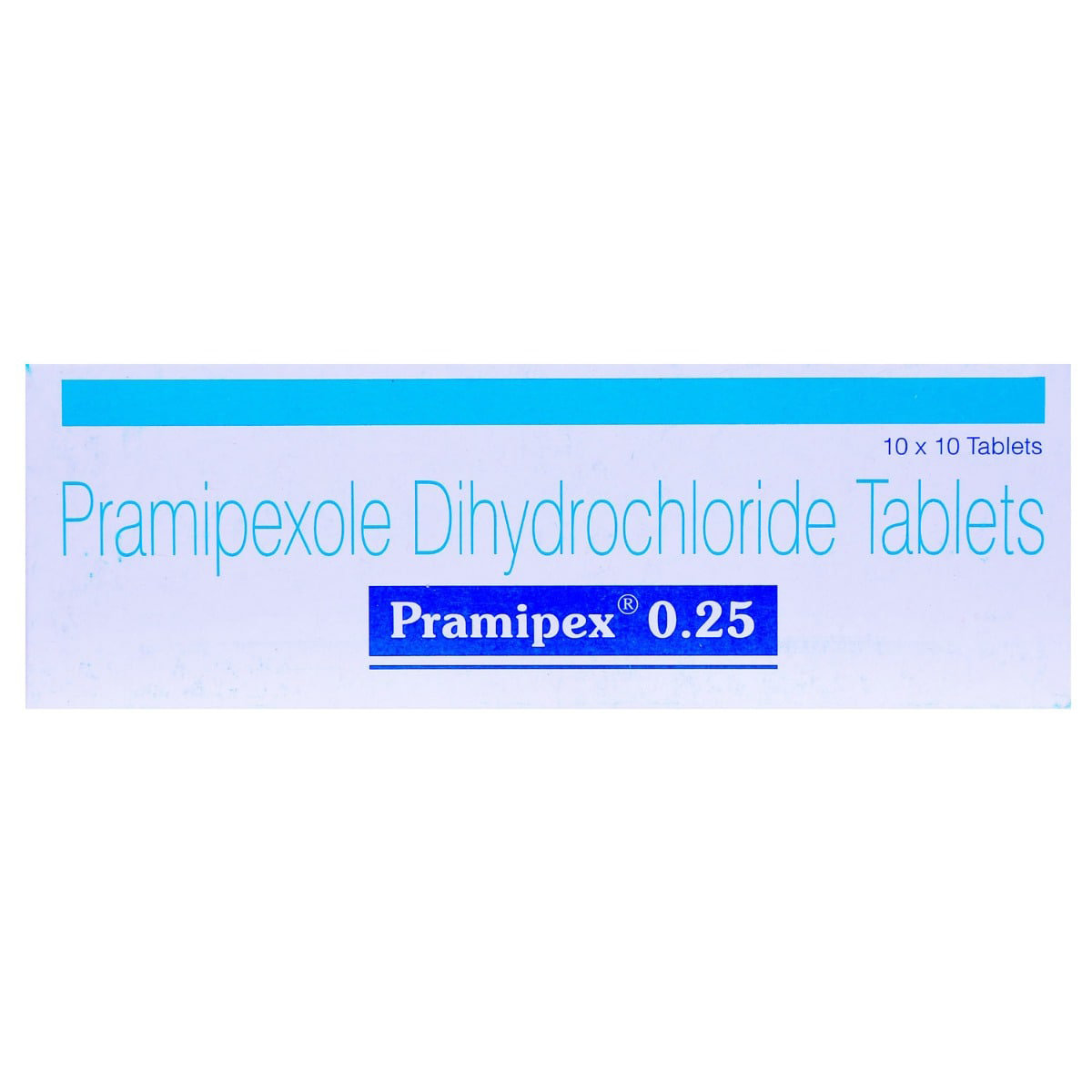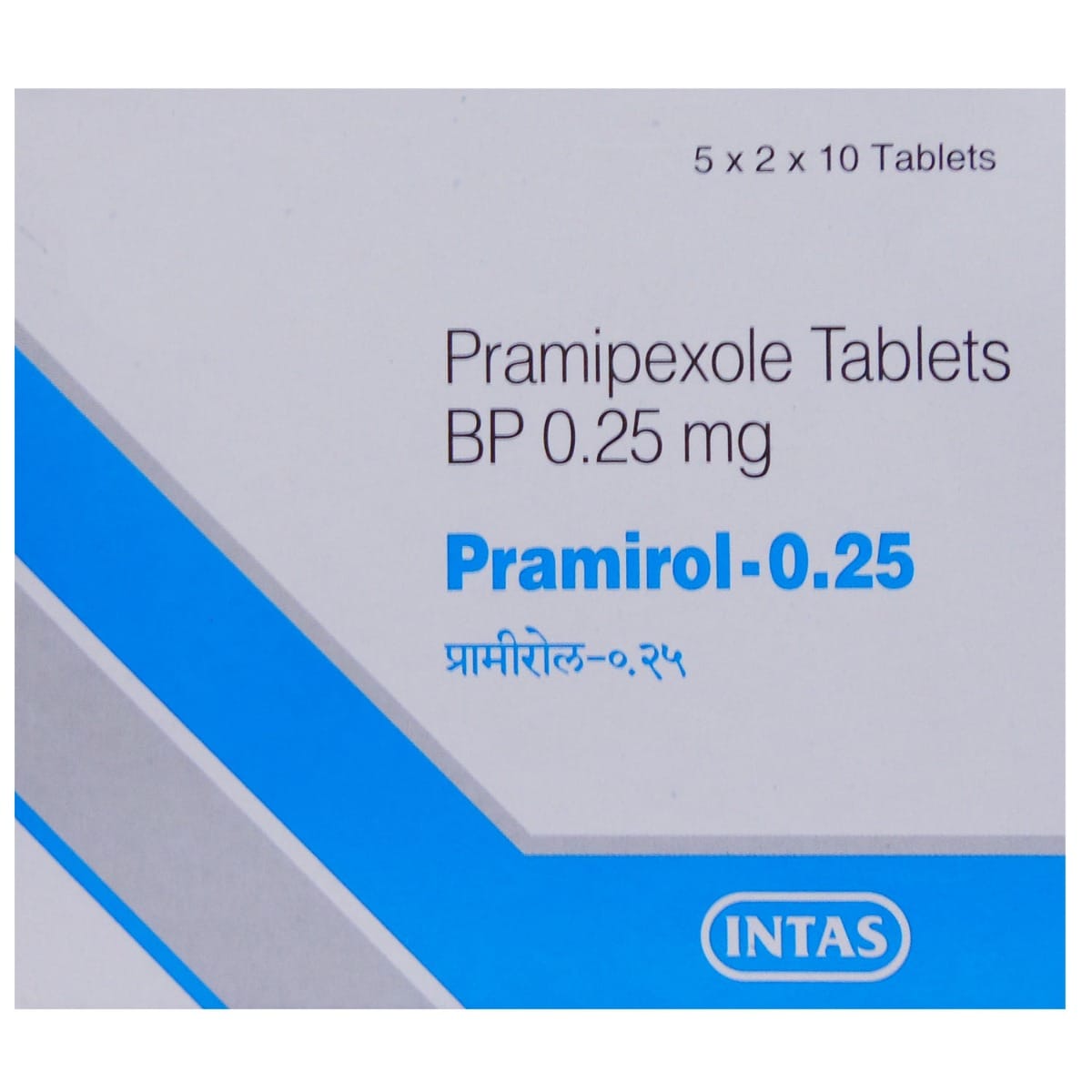Pexopram 0.25 mg Tablet 10's




MRP ₹92.5
(Inclusive of all Taxes)
₹13.9 Cashback (15%)
Provide Delivery Location
Online payment accepted
 Prescription drug
Prescription drugWhats That
Composition :
Manufacturer/Marketer :
Consume Type :
Return Policy :
Expires on or after :
About Pexopram 0.25 Mg Tablet
Pexopram 0.25 Mg Tablet belongs to a group of antiparkinson agents or dopamine agonists used to treat the symptoms of Parkinson’s disease and moderate to severe Willis-Ekbom disease (restless legs syndrome) in adults. Parkinson’s disease is a progressive neurological disorder in which the first signs are problems with movements. Willis-Ekbom disease is a condition which causes the uncontrollable urge to move the legs.
Pexopram 0.25 Mg Tablet contains 'Pramipexole' that works by mimicking the action of dopamine (acting in place of dopamine), a natural substance found in the brain needed to control body movement. This triggers the nerve impulses in the brain that control body movements.
In some cases, you may experience certain common side-effects such as sleepiness, nausea, constipation, dizziness, fatigue, hallucinations, dry mouth, muscle spasms, and peripheral oedema (leg swelling due to fluid overload). Most of these side-effects do not require medical attention and will resolve gradually over time. However, you are advised to talk to your doctor if you experience these side-effects persistently.
Do not discontinue Pexopram 0.25 Mg Tablet on your own. Consult your doctor if you are pregnant or breastfeeding. Pexopram 0.25 Mg Tablet may cause drowsiness and dizziness, do not drive unless you are alert. Pexopram 0.25 Mg Tablet should not be used in children below 18 years. Avoid consuming alcohol along with Pexopram 0.25 Mg Tablet as it could lead to increased drowsiness and dizziness. Rise slowly from sitting or lying position as Pexopram 0.25 Mg Tablet may cause orthostatic hypotension (sudden lowering in blood pressure leading to dizziness on standing).
Uses of Pexopram 0.25 Mg Tablet
Directions for Use
Medicinal Benefits
Pexopram 0.25 Mg Tablet belongs to a group of antiparkinson agents called dopamine agonists used to treat the symptoms of Parkinson’s disease and moderate to severe Willis-Ekbom disease (restless legs syndrome) in adults. Pexopram 0.25 Mg Tablet binds to the dopamine receptor and mimics its action. Dopamine is a naturally-occurring neurotransmitter in the brain. Dopamine is absent or reduced in people with Parkinson’s disease. Pexopram 0.25 Mg Tablet works by stimulating the dopamine receptors in the brain. This triggers the nerve impulses in the brain that control body movements. Pexopram 0.25 Mg Tablet helps in relieving the symptoms of Parkinson’s disease, such as muscle spasms, tremors, stiffness, and poor muscle control.
Storage
- Avoid driving or operating machinery or activities that require high focus until you know how the medication affects you.
- Maintain a fixed sleeping schedule, create a relaxing bedtime routine and ensure your sleeping space is comfortable to maximize your sleep quality.
- Limit alcohol and caffeine as these may worsen drowsiness and disturb sleep patterns.
- Drink plenty of water as it helps with alertness and keeps you hydrated and for overall well-being.
- Moderate physical activity can improve energy levels, but avoid intense workouts right before bedtime.
- Uncontrolled and involuntary movements need immediate medical attention.
- Observe your movements and try to understand and control the particular movement.
- Regularly do strengthening exercises to improve blood flow throughout the body and avoid involuntary movements.
- Implement massage techniques to enhance blood flow to organs.
- Take a balanced diet and quit smoking.
- Practice yoga and meditation to improve thought processes and reduce uncontrolled and involuntary movements.
- Hallucination is a major psychotic disorder that needs immediate medical attention.
- Acknowledge your experience and put effort to control hallucinations. You can share what is being seen with a therapist to know whether they are real or imaginary.
- Avoid smoking and alcohol intake as it can worsen the condition and increase your imagination.
- Practice meditation and yoga to avoid anxiety, which can be one of the leading causes of hallucinations.
- Talk to your dietician and consume food that can improve your mental health.
- Prepare for a restful night's sleep: Develop a calming pre-sleep routine, like reading or meditation, to help your body relax and prepare for sleep.
- Create a sleep-conducive Environment: Make bedroom a sleep haven by ensuring it is quiet, dark and calm.
- Follow a Sleep Schedule: Go to bed and get up at the same time every day to help regulate your body's internal clock and increase sleep quality.
- Try relaxing techniques like deep breathing, mindfulness meditation and any others.
- Limit stimulating activities before bedtime: Avoid stimulating activities before bedtime to improve sleep quality.
- Monitor Progress: Keep track of your sleep patterns to identify areas for improvement.
- Consult a doctor if needed: If these steps don't improve your sleep, consult a doctor for further guidance and therapy.
- Inform your doctor about dizziness symptoms. They may adjust your medication regimen or prescribe additional medications to manage symptoms.
- Follow your doctor's instructions for taking medication, and take it at the same time every day to minimize dizziness.
- When standing up, do so slowly and carefully to avoid sudden dizziness.
- Avoid making sudden movements, such as turning or bending quickly, which can exacerbate dizziness.
- Drink plenty of water throughout the day to stay hydrated and help alleviate dizziness symptoms.
- If you're feeling dizzy, sit or lie down and rest until the dizziness passes.
- Track when dizziness occurs and any factors that may trigger it, and share this information with your doctor to help manage symptoms.
- Do not stand up suddenly. Lie down and get up slowly only when you feel better.
- Avoid alcohol and large meals.
- Drink enough water before standing for long periods.
- Exercise regularly; however, avoid exercising in extreme heat.
- Eat small, low-carb meals.
- Wear compression stockings.
- Inform your doctor about the nausea and discuss possible alternatives to the medication or adjustments to the dosage.
- Divide your daily food intake into smaller, more frequent meals to reduce nausea.
- Opt for bland, easily digestible foods like crackers, toast, plain rice, bananas, and applesauce.
- Avoid certain foods that can trigger nausea, such as fatty, greasy, spicy, and smelly foods.
- Drink plenty of fluids, such as water, clear broth, or electrolyte-rich beverages like coconut water or sports drinks.
- Use ginger (tea, ale, or candies) to help relieve nausea.
- Get adequate rest and also avoid strenuous activities that can worsen nausea.
- Talk to your doctor about taking anti-nausea medication if your nausea is severe.
- Record when your nausea occurs, what triggers it, and what provides relief to help you identify patterns and manage your symptoms more effectively.
Drug Warnings
Do not take Pexopram 0.25 Mg Tablet if you are allergic to any of its contents. Talk to your doctor before taking Pexopram 0.25 Mg Tablet if you have kidney problems, hallucinations, dyskinesia (abnormal limb movements), dystonia (inability to keep the neck straight), sleepiness or suddenly falling asleep, psychosis, vision impairment, severe heart or blood vessel disease, or augmentation (symptoms start earlier). Inform your doctor if you experience symptoms such as apathy, anxiety, depression, fatigue, sweating or pain after dose reduction or stopping Pexopram 0.25 Mg Tablet . Pexopram 0.25 Mg Tablet may cause intense urges such as increased sex drive, gambling, overeating and wasting money. Consult your doctor if you are pregnant or breastfeeding. Pexopram 0.25 Mg Tablet may cause drowsiness and dizziness, do not drive unless you are alert. Pexopram 0.25 Mg Tablet should not be given to children below 18 years. Avoid consuming alcohol along with Pexopram 0.25 Mg Tablet as it could lead to increased drowsiness and dizziness. Rise slowly from sitting or lying position as Pexopram 0.25 Mg Tablet causes orthostatic hypotension (sudden lowering in blood pressure leading to dizziness on standing).
Drug-Drug Interactions
Drug-Drug Interactions
Login/Sign Up
Taking Risperidone with Pexopram 0.25 mg Tablet may reduce the effectiveness of Pexopram 0.25 mg Tablet.
How to manage the interaction:
Taking Risperidone with Pexopram 0.25 mg Tablet is not recommended as it can result in an interaction, it can be taken if a doctor has advised it. However, if you experience drowsiness, dizziness, and lightheadedness contact a doctor immediately. Do not discontinue any medications without consulting a doctor.
Taking Olanzapine with Pexopram 0.25 mg Tablet can increase the risk and severity of side effects and reduce the effectiveness of Pexopram 0.25 mg Tablet.
How to manage the interaction:
Co-administration of Olanzapine and Pexopram 0.25 mg Tablet is not recommended as it leads to an interaction, it can be taken if advised by a doctor. If you experience any symptoms such as drowsiness, dizziness, and lightheadedness, contact a doctor immediately. Avoid driving or operating dangerous machinery, and be careful while getting up from a sitting or lying position. Do not discontinue any medications without consulting a doctor.
Taking Sodium oxybate with Pexopram 0.25 mg Tablet may increase he risk of side effects.
How to manage the interaction:
Taking Pexopram 0.25 mg Tablet with Sodium oxybate together can result in an interaction, but it can be taken if a doctor has advised it. However, if you experience drowsiness, dizziness, lightheadedness, confusion, depression, low blood pressure, slow or shallow breathing, and impairment in thinking, judgment, and motor coordination, consult a doctor. Do not discontinue any medications without a doctor's advice.
Combining Esketamine with Pexopram 0.25 mg Tablet may increase side effects
How to manage the interaction:
Although taking Pexopram 0.25 mg Tablet and Esketamine together can cause an interaction, it can be taken if a doctor has suggested it. However, if you experience any symptoms like drowsiness, confusion, difficulty concentrating, and impairment in thinking, judgment, reaction speed, and motor coordination, consult a doctor. Do not discontinue the medication without consulting a doctor.
Taking Amisulpride with Pexopram 0.25 mg Tablet may decrease the efficacy of both medications.
How to manage the interaction:
Although taking amisulpride along with Pexopram 0.25 mg Tablet can result in an interaction, it can be taken if a doctor has advised it. Avoid jobs that demand mental awareness and exercise caution while rising from a sitting or sleeping posture. Do not discontinue any medications without a doctor's advice.
Drug-Food Interactions
Drug-Food Interactions
Login/Sign Up
Diet & Lifestyle Advise
- Maintain a healthy diet and exercise regularly.
- Include a diet rich in iron, folate and magnesium.
- Regularly attend therapy sessions.
- Perform meditation and yoga.
- Follow a regular sleep pattern.
- Avoid smoking and alcohol consumption.
- Learn about your condition, understand the risk factors and follow the doctor’s treatment plan.
Side Effects of Pexopram 0.25 Mg Tablet
- Nausea
- Low blood pressure
- Dizziness
- Constipation
- Fatigue
- Headache
- Dry mouth
- Muscle spasms
Habit Forming
Therapeutic Class
All Substitutes & Brand Comparisons
RX
Out of StockPramitrem 0.25 mg Tablet 10's
Ucb India Pvt Ltd
₹54.5
(₹4.91 per unit)
41% CHEAPERRX
Out of StockPramiday 0.25mg Tablet
Gentech Healthcare Pvt Ltd
₹60
(₹5.4 per unit)
35% CHEAPERRX
Out of StockParmiox 0.25Mg Tablet 10'S
Psyco Remedies Ltd
₹65
(₹5.85 per unit)
29% CHEAPER
Product Substitutes
Author Details
We provide you with authentic, trustworthy and relevant information
Drug-Diseases Interactions
Drug-Diseases Interactions
Login/Sign Up
FAQs
Pexopram 0.25 Mg Tablet works by acting like dopamine and triggering the nerve impulses in the brain that controls our body movements like restless leg syndrome and Parkinson's.
Do not discontinue Pexopram 0.25 Mg Tablet without consulting your doctor as it could lead to recurring symptoms. To treat your condition effectually, continue taking Pexopram 0.25 Mg Tablet for as long as prescribed. Do not be reluctant to speak with your doctor if you feel any difficulty while taking Pexopram 0.25 Mg Tablet .
Pexopram 0.25 Mg Tablet may lower the blood pressure than normal leading to hypotension (low blood pressure), especially during the initial days of treatment. Do not stand up suddenly, rise slowly to avoid a sudden drop in blood pressure. Regularly monitor your blood pressure levels while taking Pexopram 0.25 Mg Tablet .
Dry mouth could be a side-effect of Pexopram 0.25 Mg Tablet . Limiting caffeine intake, avoiding smoking and mouthwashes containing alcohol, drinking water regularly, and chewing sugar-free gum/candy might help in stimulating saliva and thereby prevents drying of the mouth.
Pexopram 0.25 Mg Tablet may cause peripheral oedema (swelling of lower legs and hands due to fluid overload). So, avoid sitting or standing for too long.
Hallucination is a medical condition in which the person may feel, hear or believe things that are not true, see things that are not there, feel unusually suspicious or confused. If you experience hallucinations, please talk to your doctor immediately.
Drug-Drug Interactions Checker List
- AMITRIPTYLINE
- DULOXETINE
- TRAZODONE
- FLUOXETINE
- DIPHENHYDRAMINE
- CETIRIZINE
- GABAPENTIN
- PREGABALIN
- MEMANTINE
- ACETAMINOPHEN
- HYDROCODONE
- TRAMADOL
Special Advise
Patients and their caretakers (midwife/nurse) should be alerted as Pexopram 0.25 Mg Tablet may cause intense urges such as increased sex drive, gambling, overeating and wasting money.
Disease/Condition Glossary
Parkinson’s disease: It is a progressive neurological disorder in which the first signs are problems with movements. Dopamine is a naturally-occurring neurotransmitter in the brain which is reduced or absent in people with Parkinson’s disease. Due to this problems arise with smooth and coordinated movements. Symptoms include decreased ability to smell, stooped posture, changes in voice, constipation, small/cramped handwriting, tremor, slow movements, stiffness of arms, legs, and trunk, and problems with balance.
Willis-Ekbom disease (restless leg syndrome): It is a condition which causes the uncontrollable urge to move the legs. The urge to move their legs is more intense when a person is trying to sleep or relax. This interferes with sleep leading to daytime sleepiness and fatigue. Symptoms include an uncontrollable urge to move the legs, tingling, crawling or pulling sensations in the legs.

Have a query?
Buy best C.n.s Drugs products by
Intas Pharmaceuticals Ltd
Sun Pharmaceutical Industries Ltd
Torrent Pharmaceuticals Ltd
Alkem Laboratories Ltd
Abbott India Ltd
Cipla Ltd
Alteus Biogenics Pvt Ltd
Micro Labs Ltd
Lupin Ltd
Ipca Laboratories Ltd
D D Pharmaceuticals Pvt Ltd
Icon Life Sciences
Mankind Pharma Pvt Ltd
Tripada Healthcare Pvt Ltd
Arinna Lifesciences Ltd
Linux Laboratories Pvt Ltd
East West Pharma India Pvt Ltd
La Renon Healthcare Pvt Ltd
Talent India Pvt Ltd
Tas Med India Pvt Ltd
Zydus Healthcare Ltd
Cnx Health Care Pvt Ltd
Eris Life Sciences Ltd
Leeford Healthcare Ltd
Emcure Pharmaceuticals Ltd
Macleods Pharmaceuticals Ltd
Sigmund Promedica
Aristo Pharmaceuticals Pvt Ltd
Dr Reddy's Laboratories Ltd
Troikaa Pharmaceuticals Ltd
Consern Pharma Ltd
Zydus Cadila
Shine Pharmaceuticals Ltd
Wockhardt Ltd
Ardent Life Sciences Pvt Ltd
Crescent Formulations Pvt Ltd
Theo Pharma Pvt Ltd
Reliance Formulation Pvt Ltd
Ikon Pharmaceuticals Pvt Ltd
Propel Healthcare
Neon Laboratories Ltd
Jagsam Pharma
Msn Laboratories Pvt Ltd
Morepen Laboratories Ltd
Pulse Pharmaceuticals
Sanofi India Ltd
Med Manor Organics Pvt Ltd
Hetero Healthcare Pvt Ltd
Novartis India Ltd
Crescent Therapeutics Ltd
Elder Pharmaceuticals Ltd
Solvate Laboratories Pvt Ltd
Akumentis Healthcare Ltd
Mova Pharmaceutical Pvt Ltd
Psyco Remedies Ltd
Tripada Lifecare Pvt Ltd
Ajanta Pharma Ltd
Cyrus Remedies Pvt Ltd
Medishri Healthcare Pvt Ltd
Cadila Healthcare Ltd
Glenmark Pharmaceuticals Ltd
Matteo Health Care Pvt Ltd
Hbc Life Sciences Pvt Ltd
Lyf Healthcare
Matias Healthcare Pvt Ltd
Mesmer Pharmaceuticals
Alembic Pharmaceuticals Ltd
Capital Pharma
Crescent Pharmaceuticals
Medopharm Pvt Ltd
Alniche Life Sciences Pvt Ltd
Kivi Labs Ltd
Talin Remedies Pvt Ltd
USV Pvt Ltd
Quince Lifesciences Pvt Ltd
Solis Pharmaceuticals
Infivis Life Care
Zuventus Healthcare Ltd
Cadila Pharmaceuticals Ltd
Pfizer Ltd
Wallace Pharmaceuticals Pvt Ltd
A N Pharmacia Laboratories Pvt Ltd
Blue Cross Laboratories Pvt Ltd
Jenburkt Pharmaceuticals Ltd
Lia Life Sciences Pvt Ltd
Mano Pharma
Medley Pharmaceuticals Ltd
Primus Remedies Pvt Ltd
FDC Ltd
Maneesh Pharmaceuticals Ltd
Apex Laboratories Pvt Ltd
Gagnant Healthcare Pvt Ltd
Ozone Pharmaceuticals Ltd
RPG Life Sciences Ltd
Strides Shasun Ltd
Unichem International
GlaxoSmithKline Pharmaceuticals Ltd
Kuresys Labs Pvt Ltd
LA Pharma
Trion Pharma India Llp
Alcohol
Unsafe
Avoid consumption of alcohol while taking Pexopram 0.25 Mg Tablet as it may cause increased dizziness.
Pregnancy
Caution
Please consult your doctor if you have any concerns regarding this; your doctor will prescribe only if the benefits outweigh the risks.
Breast Feeding
Unsafe
Do not take Pexopram 0.25 Mg Tablet if you are breastfeeding. Pexopram 0.25 Mg Tablet may reduce the production of breast milk. Also, it can pass into breast milk. If taking Pexopram 0.25 Mg Tablet is unavoidable, stop breastfeeding.
Driving
Unsafe
Pexopram 0.25 Mg Tablet may cause dizziness, sleepiness and hallucinations. Avoid driving and handling machinery if you experience these symptoms.
Liver
Caution
Dose adjustment may be needed in patients with liver impairment. Please consult your doctor if you have a liver impairment or any concerns regarding this.
Kidney
Caution
Dose adjustment may be needed in patients with kidney impairment. Please consult your doctor if you have kidney impairment or any concerns regarding this.
Children
Unsafe
Pexopram 0.25 Mg Tablet is not recommended for use in children below 18years.
Recommended for a 30-day course: 3 Strips










_0.jpg?tr=q-85)

